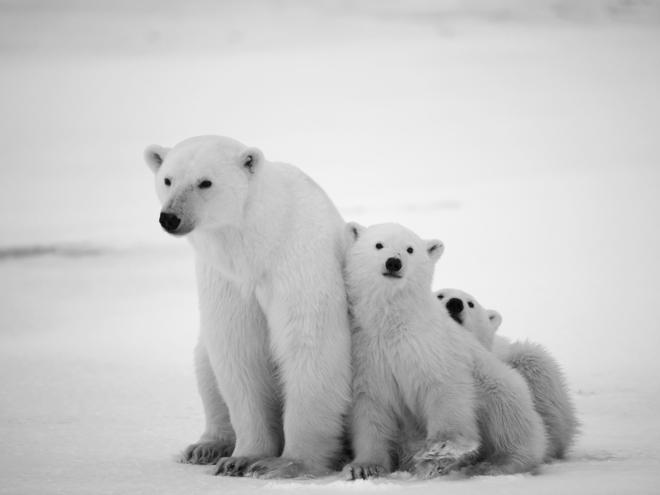Make a difference for the Polar Bears!
Remember those animal folders we loved to peruse at local supply stores, around back-to-school time? They had puppies or kittens on them? Well, to us, the best ones were the Polar Bears. Cute little balls of fur, playing in snow banks and rolling around on ice… adorable alert X10!!
But now, those cute little animals need our help. For years, we have known that the ice in the Arctic is melting because of climate change. This is no surprise, but creatures are suffering because of our negligence towards the environment. We MUST take action now and save what is left. This article will provide basic information about Polar Bears, and how you can help them.
Step 1: Know Your Polar Bears!
Polar Bears are very social animals. Sometimes, males will find other male companions during the winter and socialize a little, even though they’ll be enemies again once mating season starts. As mating season begins, males will look for any female they can find. This makes it hard for the cubs, since the male will kill them and try to have his own cubs with the mother. Most cubs do not survive because of this, which leads to even more of a decline of their species.
Where they live impacts the attributes they have. If you’ve ever looked at a polar bear, you should see that they have big paws with sharp claws. These help them in more ways than one. They can use them to climb up steep hills, or stomp on the heavy snow to find seal pups that are hiding in their dens. Polar Bears also have hollow fur, which them warm in the frigid climate of the Arctic. Since they live in cold temperatures, they need characteristics like this to survive.
When on the hunt, Polar Bears will normally be very stealthy. They have keen eyesight so they are able to see the prey and make a strategy based on what is around them. They change their strategy of catching prey every single time, since nothing really stays the same in the Arctic. On things that I’ve read and seen, they will distribute their weight evenly on ice when it starts to separate and flatten their ears in the water when going in for the kill. This makes them one of the top predators in the world.
Catching prey might seem like an interesting feat, but there are some really cool facts about Polar Bears that make them even more incredible! For example, if you’ve ever seen one roll around on the snow, have you questioned why? Well, it’s because they are squeezing out excess water from their fur. They swim very often, so doing this prevents their fur from staying too wet. Polar Bears also have 20cm (7.9in) of blubber that keeps them warm in the harsh Arctic environment. Pretty cool, right? They can move at 40kph (24.85mph) when they are at their top speed. Polar Bears are one of the most interesting animals in the world, and even though it may seem like they’re doing okay, they’re not. They need our help, and here’s why.
Step 2: Polar Bears Need the Arctic!
Polar Bears have evolved to live in the Arctic climate, and are meant to live in the chilly extremes seen up there. With average temperatures on the rise, the world is seeing Polar Bears struggling to live normally. Polar Bear prey (ringed and bearded seals, sometimes walrus, beluga, bird eggs) can all be found hanging around ice flow areas in the summer season. Polar Bears migrate from the land they stay on during the winter months to these ice flows in the transition months between spring and summer. However, with temperatures rising and total surface ice area growing smaller and smaller, bears need to swim longer distances to reach the summer ice flows and their food supply. This takes a heavy toll on young cubs, who haven’t built up enough endurance to make long-distance swims. Some Polar Bear families end up stranded on islands with very little food supply (nearly all vegetation) if they don’t decide to leave the island before all the ice melts. These bears frequently starve. National Geographic has a heart-wrenching video of a starving bear struggling to walk and search for food. Here’s a link: https://video.nationalgeographic.com/video/news/171207-polar-bear-starving-iceless-land-vin-spd
Videos and photos like these that go viral help organizations fight for climate change action plans and more, which is necessary in helping Polar Bears survive.
Step 3: How Can YOU Make a Difference?
Sometimes we ask ourselves how much impact we can truly make. Even just telling a few people about how much help these bears and our world needs will make a difference. And now, with social media booming, reposting this video or photos showing the dark truth behind climate change will reach hundreds of people. Using hashtags like these will make your photos worth even more: #actonclimate,
- Actions with Impact (https://polarbearsinternational.org/get-involved/actions-with-impact/)
- Polar Bears International
- Defenders of Wildlife
- National Geographic
There are others out there who care just as passionately as we do about these bears. They have done the research and explained what’s been going wrong. They also make it clear that YOU, our fellow human beings, can help make a difference even in the smallest of ways. Here are some other articles that might help explain what we didn’t:
- This is Our Last Chance to Save Polar Bears from Extinction (https://www.huffingtonpost.com/entry/polar-bears-climate-change_us_5873ebb2e4b02b5f858a8579)
- Without Action on Climate Change, Say Goodbye to Polar Bears (https://www.washingtonpost.com/news/energy-environment/wp/2017/01/09/without-action-on-climate-change-say-goodbye-to-polar-bears/?noredirect=on&utm_term=.65b42c355c27)
- Scientists Hatch Bold Plan to Save Polar Bears (https://www.nbcnews.com/mach/science/scientists-hatch-bold-plan-save-polar-bears-ncna851356)
- Polar Bears Really are Starving Because of Global Warming, Study Shows (https://news.nationalgeographic.com/2018/02/polar-bears-starve-melting-sea-ice-global-warming-study-beaufort-sea-environment/)
Please stay aware of climate change and what is happening to the creatures being affected by it!
Get involved, make a change, and save an animal’s life.

